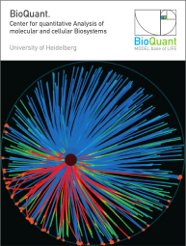Research Training Group: Mathematical Modeling for the Quantitative Biosciences (MMQB)
Regulation of cell-to-cell variability in prokaryotes - BioQuant_Bischofs0116 [position filled]
Supervisor and leader of the experimental laboratory: Dr. Ilka Bischofs-Pfeifer (BioQuant & ZMBH, MPI for Terrestrial Microbiology)
Background:
A certain amount of noise in gene expression is unavoidable and the consequence of the inherent stochastic nature of biomolecular events inside the cell. If this noise is beneficial, it could be evolved, e.g. by influencing transcription via changes in the promoter region. While rules have already been derived for how promoter architecture can control noise independently from mean expression in eukaryotes, research on this topic in prokaryotes is – surprisingly - still in its infancy (Sanchez et al., 2013, Jones et al., 2014).
Project goal and planned work:
In this project, we aim to develop thermodynamic and chemical kinetic models to describe the noisy gene-regulatory function in prokaryotes by focusing on synthetically engineered target promoters. We will do this by integrating (i) single cell data with gene expression measured with the help of fluorescent reporters under various conditions with (ii) biochemical and biophysical data that characterize relevant interactions in the promoter region. Both are collected by our own lab following previous work on promoters in Bacillus subtilis, regulated by the master regulator of quorum sensing, the latter being a form of cell-cell communication in bacteria (Wolf et al. 2016). This way, we will derive design principles for how promoter architecture could regulate noise. Ultimately, the detailed promoter models could be integrated with models of gene-regulatory network modules (Babel et al. 2016, Drees et al. 2014, Bischofs et al., 2009) to facilitate a comprehensive understanding of how cell-to-cell variability is regulated by a bacterial communication system.
Collaborations within the RTG:
This project on gene regulation in prokaryotes is directly related to the project of Thomas Höfer, studying gene regulation in eukaryotes. Methodological exchange will take place with the groups of U. Kummer (COPASI), A. Marciniak-Czochra and U. Schwarz (stochastic modeling). Further interactions are envisaged, as gene regulation is an integral part of the regulatory networks studied in the projects by U. Kummer and N. Grabe.
List of relevant publications:
- A. Sanchez, S. Choubey, J. Kondev. Regulation of Noise in Gene Expression. Annual Reviews of Biophysics, 2013
- D.L. Jones, R.C. Brewster, R. Phillips. Promoter architecture dictates cell-to-cell variability in gene expression, Science, 346(6216), 2014
- H. Babel and I.B. Bischofs. Molecular and Cellular Factors Control Signal Transduction via Switchable Allosteric Modulator Proteins (SAMPs). BMC Systems Biology 10:35, 2016
- B. Drees, M. Reiger, K. Jung and I.B. Bischofs. A Modular View of the Diversity of Cell-Density-Encoding Schemes in Bacterial Quorum-Sensing Systems. Biophysical Journal 107, 266-277, 2014
- I.B. Bischofs, J. Hug, A. Liu, D.M. Wolf and A.P. Arkin. Complexity in bacterial cell-cell communication: Quorum signal integration and subpopulation signaling in the B. subtilis phosphorelay. Proc. Nat. Acad. USA, 106(16), 6459-6464, 2009
- D. Wolf, V. Rippa, J.C. Mobarec, P.Sauer, L. Adlung, P. Kolb and I. B. Bischofs. The quorum sensing regulator ComA from Bacillus subtilis activates transcription using topologically distinct DNA motifs, Nucleic Acids Research 44 (5), 2160-2172, 2016
Application: If you would like to apply for one of these PhD research projects, please click here and follow the instructions on the HBIGS website.


